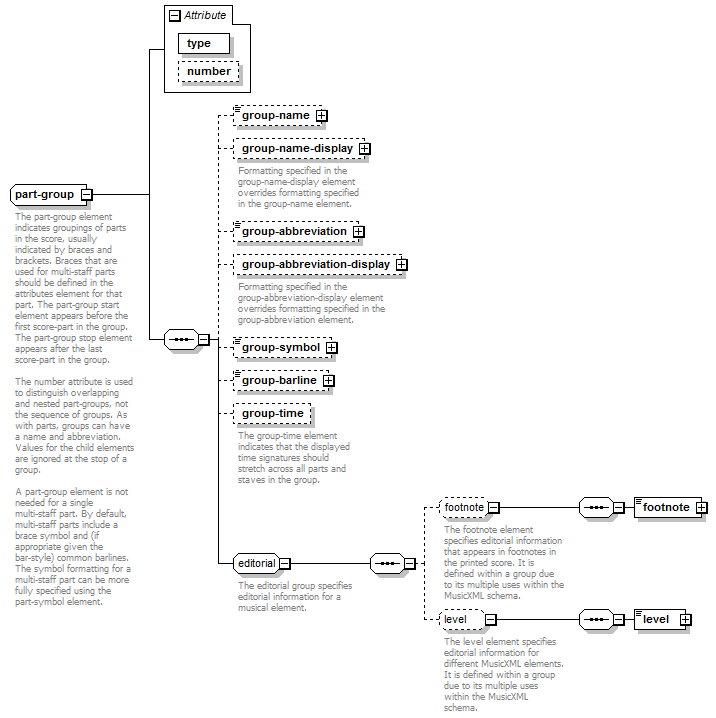part-group
The part-group element indicates groupings of parts in the score, usually indicated by braces and brackets. Braces that are used for multi-staff parts should be defined in the attributes element for that part. The part-group start element appears before the first score-part in the group. The part-group stop element appears after the last score-part in the group. The number attribute is used to distinguish overlapping and nested part-groups, not the sequence of groups. As with parts, groups can have a name and abbreviation. Values for the child elements are ignored at the stop of a group. A part-group element is not needed for a single multi-staff part. By default, multi-staff parts include a brace symbol and (if appropriate given the bar-style) common barlines. The symbol formatting for a multi-staff part can be more fully specified using the part-symbol element. |
Complex Type Information
Model

Attributes
| QName | Type | Fixed | Default | Use | Inheritable | Annotation |
|---|---|---|---|---|---|---|
| number | xs:token | 1 | optional | |||
| type | start-stop | required |
Used By
| Element | part-group/part-group |
Source
<xs:complexType name="part-group"> <xs:annotation> <xs:documentation>The part-group element indicates groupings of parts in the score, usually indicated by braces and brackets. Braces that are used for multi-staff parts should be defined in the attributes element for that part. The part-group start element appears before the first score-part in the group. The part-group stop element appears after the last score-part in the group. The number attribute is used to distinguish overlapping and nested part-groups, not the sequence of groups. As with parts, groups can have a name and abbreviation. Values for the child elements are ignored at the stop of a group. A part-group element is not needed for a single multi-staff part. By default, multi-staff parts include a brace symbol and (if appropriate given the bar-style) common barlines. The symbol formatting for a multi-staff part can be more fully specified using the part-symbol element.</xs:documentation> </xs:annotation> <xs:sequence> <xs:element name="group-name" type="group-name" minOccurs="0"/> <xs:element name="group-name-display" type="name-display" minOccurs="0"> <xs:annotation> <xs:documentation>Formatting specified in the group-name-display element overrides formatting specified in the group-name element.</xs:documentation> </xs:annotation> </xs:element> <xs:element name="group-abbreviation" type="group-name" minOccurs="0"/> <xs:element name="group-abbreviation-display" type="name-display" minOccurs="0"> <xs:annotation> <xs:documentation>Formatting specified in the group-abbreviation-display element overrides formatting specified in the group-abbreviation element.</xs:documentation> </xs:annotation> </xs:element> <xs:element name="group-symbol" type="group-symbol" minOccurs="0"/> <xs:element name="group-barline" type="group-barline" minOccurs="0"/> <xs:element name="group-time" type="empty" minOccurs="0"> <xs:annotation> <xs:documentation>The group-time element indicates that the displayed time signatures should stretch across all parts and staves in the group.</xs:documentation> </xs:annotation> </xs:element> <xs:group ref="editorial"/> </xs:sequence> <xs:attribute name="type" type="start-stop" use="required"/> <xs:attribute name="number" type="xs:token" default="1"/> </xs:complexType> |